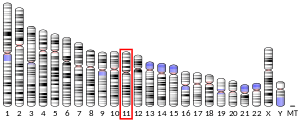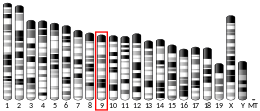ROMK
The renal outer medullary potassium channel (ROMK) is an ATP-dependent potassium channel (Kir1.1) that transports potassium out of cells. It plays an important role in potassium recycling in the thick ascending limb (TAL) and potassium secretion in the cortical collecting duct (CCD) of the nephron. In humans, ROMK is encoded by the KCNJ1 (potassium inwardly-rectifying channel, subfamily J, member 1) gene.[5][6][7] Multiple transcript variants encoding different isoforms have been found for this gene.[8]
Function
Potassium channels are present in most mammalian cells, where they participate in a wide range of physiologic responses. The protein encoded by this gene is an integral membrane protein and inward-rectifier type potassium channel. It is inhibited by internal ATP and probably plays an important role in potassium homeostasis. The encoded protein has a greater tendency to allow potassium to flow into a cell rather than out of a cell (hence the term "inwardly rectifying").[8] ROMK was identified as the pore-forming component of the mitochondrial ATP-sensitive potassium (mitoKATP) channel, known to play a critical role in cardioprotection against ischemic-reperfusion injury in the heart[9] as well as in the protection against hypoxia-induced brain injury from stroke or other ischemic attacks.
Klotho is a beta-glucuronidase-like enzyme that activates ROMK by removal of sialic acid.[10][11]
Clinical significance
Mutations in this gene have been associated with antenatal Bartter syndrome, which is characterized by salt wasting, hypokalemic alkalosis, hypercalciuria, and low blood pressure.[8]
Role in hypokalemia and magnesium deficiency
The ROMK channels are inhibited by magnesium in the nephron's normal physiologic state. In states of hypokalemia (a state of potassium deficiency), concurrent magnesium deficiency results in a state of hypokalemia that may be more difficult to correct with potassium replacement alone. This may be directly due to decreased inhibition of the outward potassium current in states where magnesium is low. Conversely, magnesium deficiency alone is not likely to cause a state of hypokalemia.[12]
References
- GRCh38: Ensembl release 89: ENSG00000151704 - Ensembl, May 2017
- GRCm38: Ensembl release 89: ENSMUSG00000041248 - Ensembl, May 2017
- "Human PubMed Reference:". National Center for Biotechnology Information, U.S. National Library of Medicine.
- "Mouse PubMed Reference:". National Center for Biotechnology Information, U.S. National Library of Medicine.
- Ho K, Nichols CG, Lederer WJ, Lytton J, Vassilev PM, Kanazirska MV, Hebert SC (March 1993). "Cloning and expression of an inwardly rectifying ATP-regulated potassium channel". Nature. 362 (6415): 31–8. doi:10.1038/362031a0. PMID 7680431.
- Yano H, Philipson LH, Kugler JL, Tokuyama Y, Davis EM, Le Beau MM, Nelson DJ, Bell GI, Takeda J (May 1994). "Alternative splicing of human inwardly rectifying K+ channel ROMK1 mRNA". Molecular Pharmacology. 45 (5): 854–60. PMID 8190102.
- Kubo Y, Adelman JP, Clapham DE, Jan LY, Karschin A, Kurachi Y, Lazdunski M, Nichols CG, Seino S, Vandenberg CA (December 2005). "International Union of Pharmacology. LIV. Nomenclature and molecular relationships of inwardly rectifying potassium channels". Pharmacological Reviews. 57 (4): 509–26. doi:10.1124/pr.57.4.11. PMID 16382105.
- "Entrez Gene: potassium inwardly-rectifying channel".
- Foster DB, Ho AS, Rucker J, Garlid AO, Chen L, Sidor A, Garlid KD, O'Rourke B (August 2012). "Mitochondrial ROMK channel is a molecular component of mitoK(ATP)". Circulation Research. 111 (4): 446–54. doi:10.1161/circresaha.112.266445. PMC 3560389. PMID 22811560.
- Cha SK, Ortega B, Kurosu H, Rosenblatt KP, Kuro-O M, Huang CL (2008). "Removal of sialic acid involving Klotho causes cell-surface retention of TRPV5 channel via binding to galectin-1". Proceedings of the National Academy of Sciences of the United States of America. 105 (28): 9805–9810. doi:10.1073/pnas.0803223105. PMC 2474477. PMID 18606998.
- Huang CL (2010). "Regulation of ion channels by secreted Klotho: mechanisms and implications". Kidney International. 77 (10): 855–860. doi:10.1038/ki.2010.73. PMID 20375979.
- Huang, Chou-Long; Kuo, Elizabeth (2007). "Mechanism of Hypokalemia in Magnesium Deficiency". Journal of the American Society of Nephrology. 18 (10): 2649–2652. doi:10.1681/asn.2007070792. PMID 17804670.
Further reading
- O'Connell AD, Leng Q, Dong K, MacGregor GG, Giebisch G, Hebert SC (July 2005). "Phosphorylation-regulated endoplasmic reticulum retention signal in the renal outer-medullary K+ channel (ROMK)". Proceedings of the National Academy of Sciences of the United States of America. 102 (28): 9954–9. doi:10.1073/pnas.0504332102. PMC 1175014. PMID 15987778.
- Kubo Y, Adelman JP, Clapham DE, Jan LY, Karschin A, Kurachi Y, Lazdunski M, Nichols CG, Seino S, Vandenberg CA (December 2005). "International Union of Pharmacology. LIV. Nomenclature and molecular relationships of inwardly rectifying potassium channels". Pharmacological Reviews. 57 (4): 509–26. doi:10.1124/pr.57.4.11. PMID 16382105.
- Brochard K, Boyer O, Blanchard A, Loirat C, Niaudet P, Macher MA, Deschenes G, Bensman A, Decramer S, Cochat P, Morin D, Broux F, Caillez M, Guyot C, Novo R, Jeunemaître X, Vargas-Poussou R (May 2009). "Phenotype-genotype correlation in antenatal and neonatal variants of Bartter syndrome". Nephrology, Dialysis, Transplantation. 24 (5): 1455–64. doi:10.1093/ndt/gfn689. PMID 19096086.
- Lee JR, Shieh RC (March 2009). "Structural changes in the cytoplasmic pore of the Kir1.1 channel during pHi-gating probed by FRET". Journal of Biomedical Science. 16 (1): 29. doi:10.1186/1423-0127-16-29. PMC 2672938. PMID 19272129.
- Nüsing RM, Pantalone F, Gröne HJ, Seyberth HW, Wegmann M (June 2005). "Expression of the potassium channel ROMK in adult and fetal human kidney". Histochemistry and Cell Biology. 123 (6): 553–9. doi:10.1007/s00418-004-0742-5. PMID 15895241.
- Cho JT, Guay-Woodford LM (February 2003). "Heterozygous mutations of the gene for Kir 1.1 (ROMK) in antenatal Bartter syndrome presenting with transient hyperkalemia, evolving to a benign course". Journal of Korean Medical Science. 18 (1): 65–8. doi:10.3346/jkms.2003.18.1.65. PMC 3055000. PMID 12589089.
- Ji W, Foo JN, O'Roak BJ, Zhao H, Larson MG, Simon DB, Newton-Cheh C, State MW, Levy D, Lifton RP (May 2008). "Rare independent mutations in renal salt handling genes contribute to blood pressure variation". Nature Genetics. 40 (5): 592–599. doi:10.1038/ng.118. PMC 3766631. PMID 18391953.
- Nozu K, Fu XJ, Kaito H, Kanda K, Yokoyama N, Przybyslaw Krol R, Nakajima T, Kajiyama M, Iijima K, Matsuo M (August 2007). "A novel mutation in KCNJ1 in a Bartter syndrome case diagnosed as pseudohypoaldosteronism" (PDF). Pediatric Nephrology. 22 (8): 1219–23. doi:10.1007/s00467-007-0468-4. PMID 17401586.
- Lin D, Kamsteeg EJ, Zhang Y, Jin Y, Sterling H, Yue P, Roos M, Duffield A, Spencer J, Caplan M, Wang WH (March 2008). "Expression of tetraspan protein CD63 activates protein-tyrosine kinase (PTK) and enhances the PTK-induced inhibition of ROMK channels". The Journal of Biological Chemistry. 283 (12): 7674–81. doi:10.1074/jbc.M705574200. PMID 18211905.
- Wang HR, Liu Z, Huang CL (August 2008). "Domains of WNK1 kinase in the regulation of ROMK1". American Journal of Physiology. Renal Physiology. 295 (2): F438–45. doi:10.1152/ajprenal.90287.2008. PMC 2519181. PMID 18550644.
- Yoo D, Kim BY, Campo C, Nance L, King A, Maouyo D, Welling PA (June 2003). "Cell surface expression of the ROMK (Kir 1.1) channel is regulated by the aldosterone-induced kinase, SGK-1, and protein kinase A". The Journal of Biological Chemistry. 278 (25): 23066–75. doi:10.1074/jbc.M212301200. PMID 12684516.
- Cha SK, Hu MC, Kurosu H, Kuro-o M, Moe O, Huang CL (July 2009). "Regulation of renal outer medullary potassium channel and renal K(+) excretion by Klotho". Molecular Pharmacology. 76 (1): 38–46. doi:10.1124/mol.109.055780. PMC 2701452. PMID 19349416.
- Nanazashvili M, Li H, Palmer LG, Walters DE, Sackin H (2007). "Moving the pH gate of the Kir1.1 inward rectifier channel". Channels. 1 (1): 21–8. doi:10.4161/chan.3707. PMID 19170254.
- Liu Z, Wang HR, Huang CL (May 2009). "Regulation of ROMK channel and K+ homeostasis by kidney-specific WNK1 kinase". The Journal of Biological Chemistry. 284 (18): 12198–206. doi:10.1074/jbc.M806551200. PMC 2673288. PMID 19244242.
- Yoo D, Flagg TP, Olsen O, Raghuram V, Foskett JK, Welling PA (February 2004). "Assembly and trafficking of a multiprotein ROMK (Kir 1.1) channel complex by PDZ interactions". The Journal of Biological Chemistry. 279 (8): 6863–73. doi:10.1074/jbc.M311599200. PMID 14604981.
- Tobin MD, Tomaszewski M, Braund PS, Hajat C, Raleigh SM, Palmer TM, Caulfield M, Burton PR, Samani NJ (June 2008). "Common variants in genes underlying monogenic hypertension and hypotension and blood pressure in the general population". Hypertension. 51 (6): 1658–64. doi:10.1161/HYPERTENSIONAHA.108.112664. PMID 18443236.
- He G, Wang HR, Huang SK, Huang CL (April 2007). "Intersectin links WNK kinases to endocytosis of ROMK1". The Journal of Clinical Investigation. 117 (4): 1078–87. doi:10.1172/JCI30087. PMC 1821066. PMID 17380208.
- Murthy M, Cope G, O'Shaughnessy KM (October 2008). "The acidic motif of WNK4 is crucial for its interaction with the K channel ROMK". Biochemical and Biophysical Research Communications. 375 (4): 651–4. doi:10.1016/j.bbrc.2008.08.076. PMID 18755144.
- Lazrak A, Liu Z, Huang CL (January 2006). "Antagonistic regulation of ROMK by long and kidney-specific WNK1 isoforms". Proceedings of the National Academy of Sciences of the United States of America. 103 (5): 1615–20. doi:10.1073/pnas.0510609103. PMC 1360592. PMID 16428287.
- Welling PA, Ho K (October 2009). "A comprehensive guide to the ROMK potassium channel: form and function in health and disease". American Journal of Physiology. Renal Physiology. 297 (4): F849–63. doi:10.1152/ajprenal.00181.2009. PMC 2775575. PMID 19458126.
External links
- ROMK1+protein,+human at the US National Library of Medicine Medical Subject Headings (MeSH)
- NDI terminology page
This article incorporates text from the United States National Library of Medicine, which is in the public domain.



